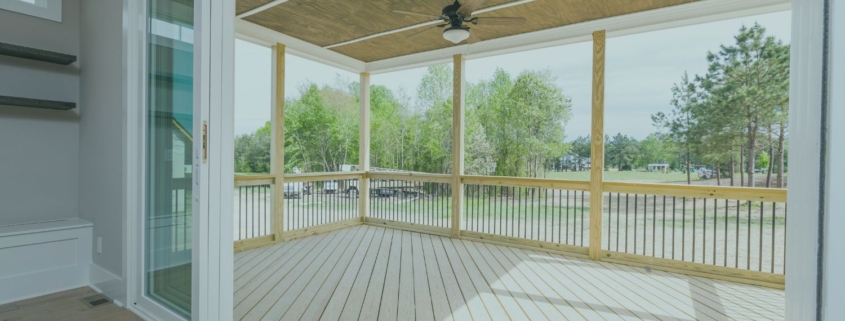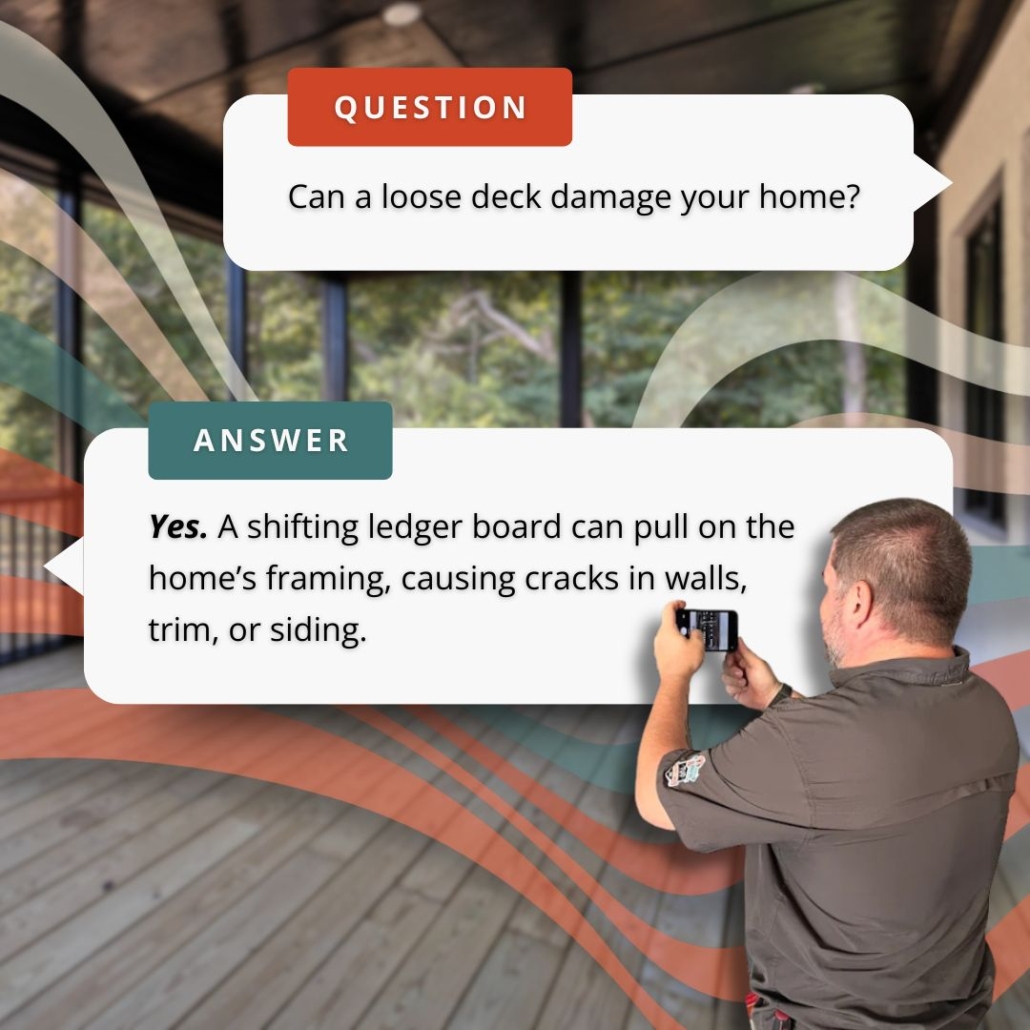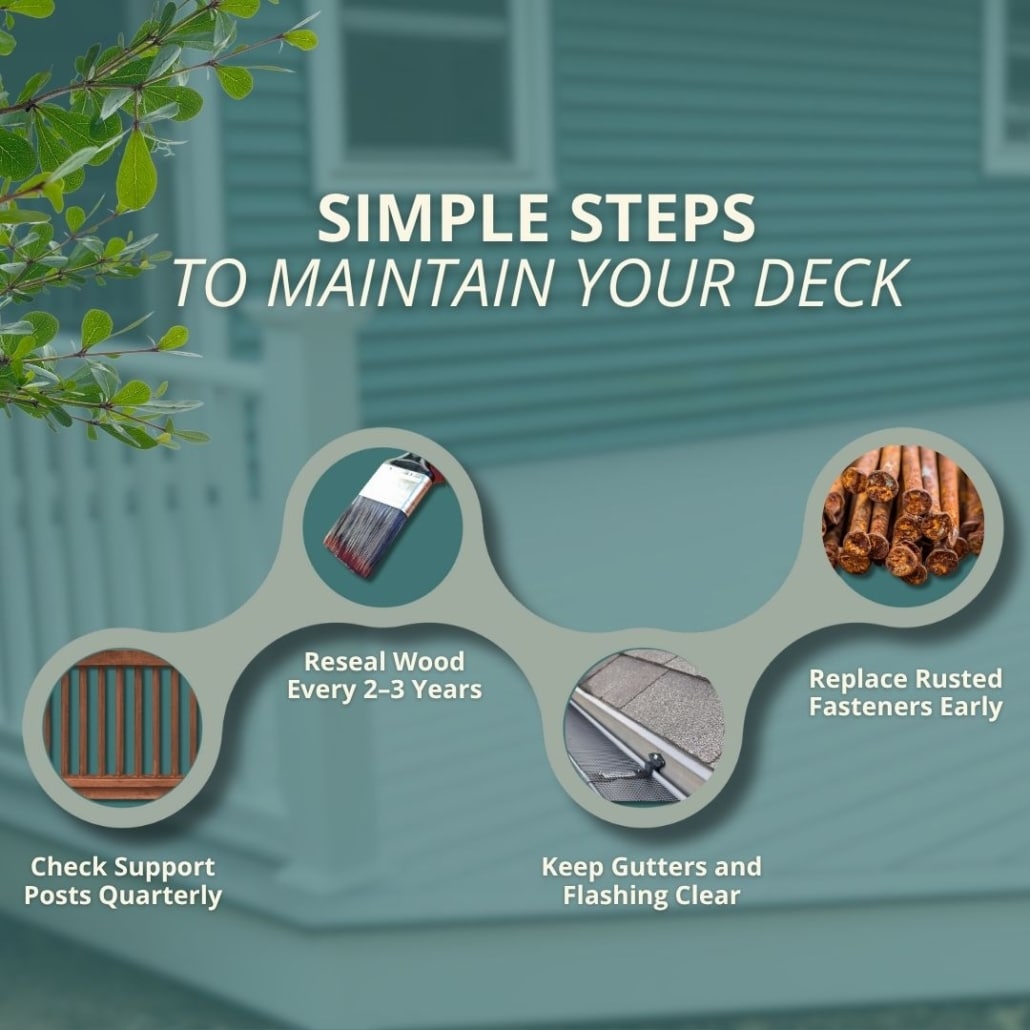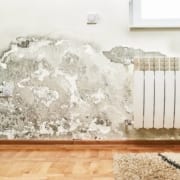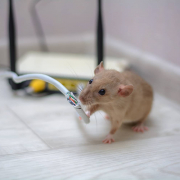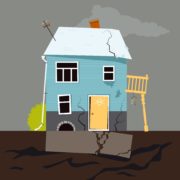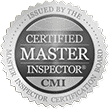How Your Deck Ledger Board Affects the Whole House
When most homeowners think about deck problems, they picture loose handrails or cracked boards. But there’s one part that matters more than any other when it comes to safety and structure: the ledger board.
The ledger board connects your deck to your home. If that connection weakens, it can cause water intrusion, wood decay, or even structural instability that spreads beyond the deck itself.
At Inside & Out Property Inspectors, we inspect this area closely during every home and deck inspection because it’s one of the most common places for failure. Here’s how your ledger board affects your whole house, what warning signs to look for, and how routine inspections can protect your property.
What Is a Deck Ledger Board?
The ledger board is a horizontal support beam that attaches the deck directly to your home’s framing. It’s what ties the deck structure into the house, keeping it secure and level.
When properly installed, it handles part of the deck’s weight and transfers that load into your home’s structure. When it’s not properly fastened, sealed, or maintained, it can create both safety and moisture issues.
Inspectors focus on this area because…
- It’s the most common point of deck failure.
- Hidden damage is often invisible from the deck surface.
- Small gaps or cracks can let water and pests into the home.
A ledger board that starts to rot or pull away doesn’t just endanger the deck. It can also weaken nearby walls, siding, and interior framing.
Why the Ledger Board Is So Important During Inspections
During a home or deck inspection, the ledger board receives special attention because it’s the anchor point that determines the safety of the entire structure.
Here’s why it matters so much:
- Deck Safety:
Ledger failures are a leading cause of deck collapses. When the board starts to separate, the deck can shift or completely pull away from the home. - Water Damage Prevention:
Without proper flashing, water seeps behind the ledger and into wall cavities. Over time, this creates rot and mold that can affect both the deck and interior framing. - Foundation Protection:
A loose deck connection can push and pull against the home’s rim joist or foundation line, adding unnecessary stress that leads to cracks or settling. - Standard Compliance:
Florida’s building standards require specific fasteners, flashing materials, and installation methods. Inspectors confirm that the deck meets these standards for safety and resale value.
Inspector Insight: The ledger board is one of the most critical inspection points for any deck. A secure connection ensures stability and prevents costly damage to the home itself.
How Ledger Board Problems Begin
Ledger board problems rarely happen overnight. They build up slowly due to moisture, poor materials, or shortcuts during construction.
Common causes:
- Water infiltration from missing or damaged flashing
- Use of nails instead of bolts or lag screws
- Poor waterproofing or untreated lumber
- Settling of the foundation or shifting of deck footings
- Pest damage, especially termites or carpenter ants, in humid climates like Florida
Over time, these issues can cause the ledger to weaken and separate from the home. During inspections, our team often spots early signs such as discoloration, rusted fasteners, or soft wood that feels spongy when tested.
Warning Signs to Watch For
Even without a trained eye, you can often spot the early warning signs of a ledger board issue:
- Small gaps where the deck meets the home
- Loose or rusted bolts and hardware
- Staining, mold, or peeling paint around the connection
- Uneven or shifting deck boards near the house
- Musty odors from trapped moisture under the deck
- Cracks forming in nearby drywall or trim indoors
If you notice any of these, it’s time to schedule a professional inspection. These clues often mean there’s water, decay, or movement behind the scenes that needs attention before it spreads.
How a Compromised Ledger Board Affects the Whole Home
A damaged or poorly installed ledger board can impact more than the deck itself. Here’s what inspectors often uncover during evaluations:
1. Structural Weakening
A separating ledger transfers stress to the home’s framing. Over time, this movement can cause cracks in interior walls or gaps along the exterior siding.
2. Water Intrusion and Mold
When flashing fails, water runs down the back of the ledger board and into the wall. This moisture can soak insulation and framing, creating mold and weakening materials.
3. Pest Activity
Moisture attracts wood-destroying insects and other pests. During inspections, we often find evidence of termites or ants near deteriorated ledger boards.
4. Unsafe Deck Conditions
A loose connection allows the deck to shift slightly with every step. Over time, that movement widens gaps and loosens bolts, setting up the deck for structural failure.
By catching these problems early through inspection, homeowners can prevent serious repairs to both the deck and the home’s structure.
What Inspectors Look For During a Deck Inspection
A professional deck inspection from Inside & Out Property Inspectors checks every key element for safety, stability, and signs of damage.
During an inspection, we look for…
- A secure connection between the deck and the home
- Strong support posts and level surfaces
- Proper drainage and intact flashing
- Rust-free bolts, joist hangers, and hardware
- Sturdy railings, stairs, and balusters
- Signs of rot, mold, or insect activity
We also check how the deck interacts with the home, ensuring no water or structural stress affects siding or framing.
If issues appear, your inspection report includes photos and clear recommendations for repair or maintenance.
Homeowner Tip: A small leak at the deck connection can turn into major damage inside the wall. Annual inspections are one of the simplest ways to protect your investment.
Other Deck Issues That Can Affect the Home
While the ledger board is often the primary concern, several other deck components also influence the home’s safety and condition.
1. Support Posts and Footings
Inspectors check for signs of settling, tilting, or moisture rot. When footings sink or posts absorb water, the entire deck may shift and strain the ledger connection.
2. Railings and Balusters
Loose or corroded railings create safety hazards. During inspections, these are tested for movement and checked against local code requirements.
3. Deck Surface and Drainage
Poor drainage allows water to pool against the house. This encourages both wood rot and insect activity. We often recommend re-sloping deck boards or improving water runoff to protect the ledger area.
4. Fasteners and Connectors
Rust or corrosion on screws, clips, bolts, or joist hangers weakens the entire framework. Regular maintenance and inspections catch these early.
5. Flashing and Siding
Flashing protects the point where the house and deck meet. Missing or damaged flashing is one of the most common reasons inspectors find moisture damage behind ledger boards.
Deck Safety and Long-Term Maintenance
Routine deck inspections are essential, especially in Florida’s climate, where humidity accelerates wood decay. To extend the life of your deck and prevent future ledger issues:
- Keep gutters and downspouts clear so rainwater doesn’t splash against the ledger area.
- Trim vegetation away from the deck to improve airflow and reduce moisture.
- Replace damaged or corroded fasteners as soon as they appear.
- Reseal or waterproof exposed wood surfaces every two to three years.
- Schedule a professional deck inspection at least once every few years, or after major storms.
Even decks that look fine on the surface can hide serious problems beneath. Professional inspections reveal issues that DIY checks might miss.
Related Homeowner Questions
How often should a deck be inspected?
Most inspectors recommend checking your deck every two to three years. Older decks or those exposed to heavy rain or sun should be inspected annually. Learn more about what happens during a full home inspection in our other resources.
Can water damage behind the ledger board spread indoors?
Yes. Once water seeps behind siding, it can travel through insulation and framing to cause staining or rot. This is why inspectors often use moisture meters near the deck wall during full moisture intrusion inspections.
What should I do if my deck feels uneven near the house?
That can signal a loose ledger board, shifting posts, or wood rot. A certified inspector can determine the exact cause and recommend the next steps before it becomes unsafe.
When to Schedule a Professional Inspection
If your deck is more than ten years old, or you’ve noticed signs of moisture, soft wood, or loose connections, it’s time to schedule an inspection.
At Inside & Out Property Inspectors, we evaluate every component that connects your deck to your home. Our licensed inspectors look for moisture damage, fastener integrity, flashing condition, and any movement that could compromise safety.
We provide clear, detailed reports so you can take action confidently and protect your property’s structure.
Pro Tip: Schedule deck inspections during the spring or early summer. Warm, humid weather makes moisture issues and wood movement easier to detect.
Conclusion
Your deck ledger board might be out of sight, but it’s one of the most important structural connections in your entire home. A small weakness here can lead to water damage, pest activity, or even deck collapse.
Regular inspections by Inside & Out Property Inspectors ensure your deck and home remain safe, secure, and ready to handle Florida’s tough weather conditions. Whether you’re maintaining your current home or buying a new one, our team helps you stay ahead of issues before they become costly repairs.
